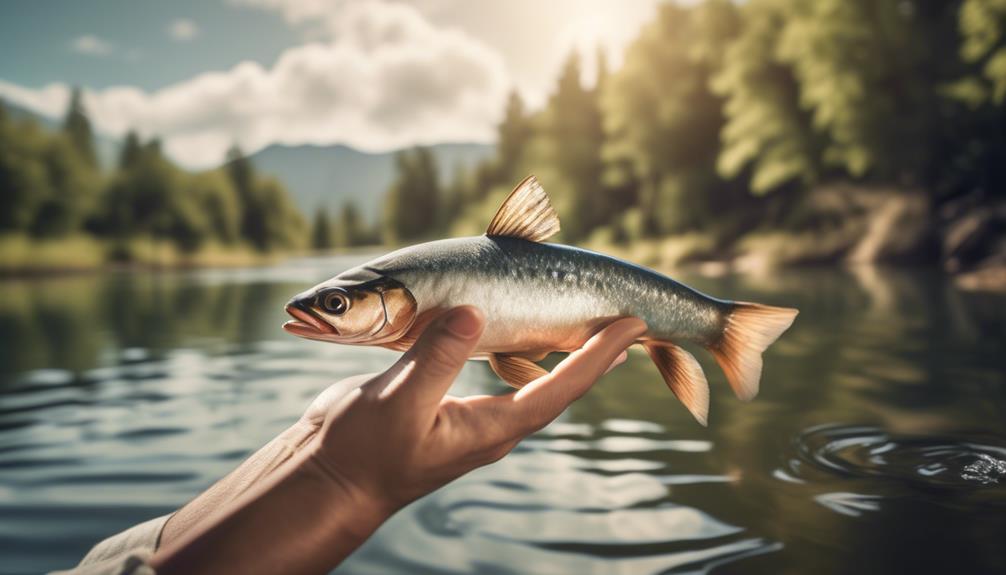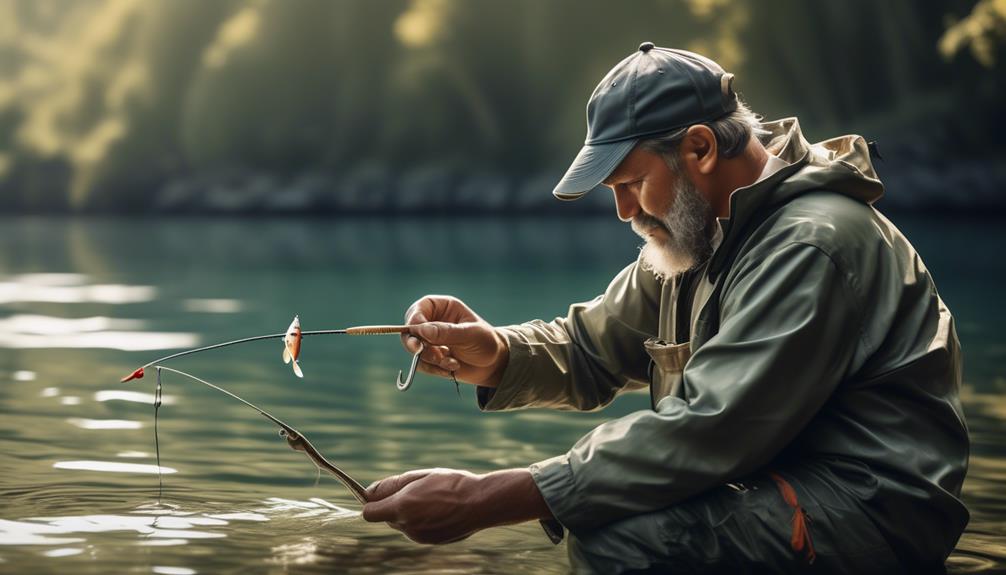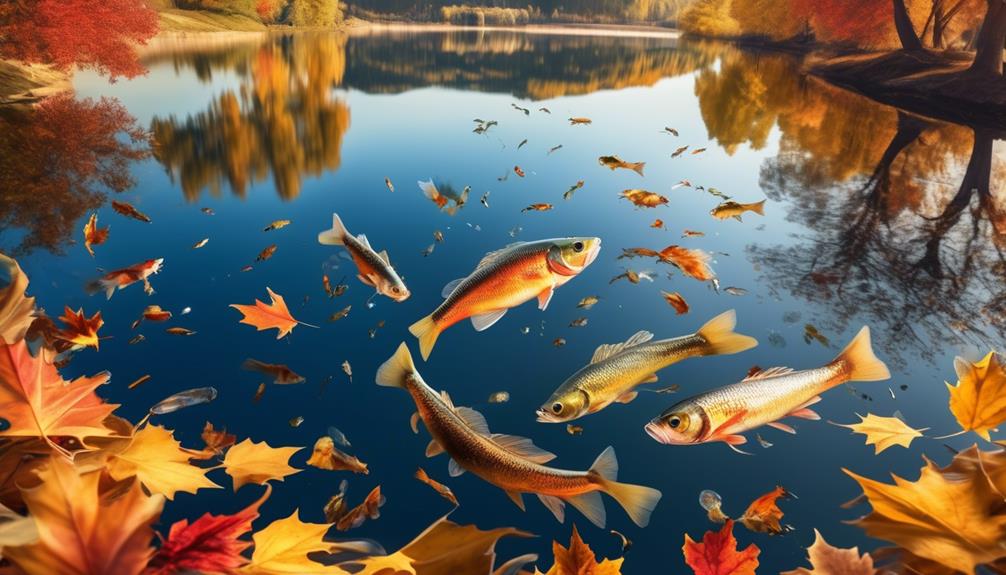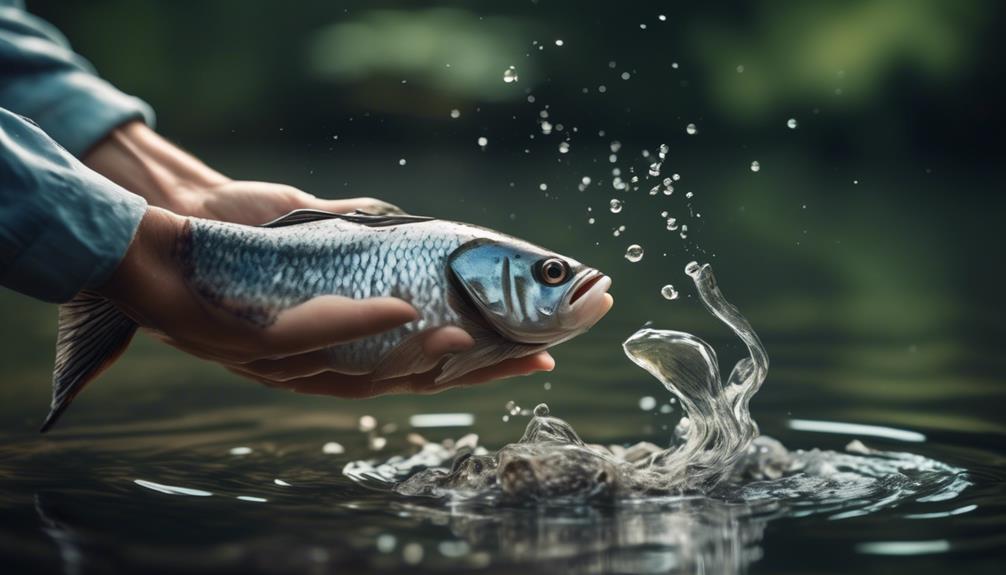Have you ever stopped to think about the impact of your fishing practices on the environment and the fish population? Whether you're a seasoned angler or a novice fisherman, the decision between catch and release and keeping fish is a crucial one.
There are several key considerations to keep in mind when making this choice, and in this discussion, we'll explore four key tips to help you navigate this decision with knowledge and responsibility.
These tips will not only enhance your fishing experience but also contribute to the conservation of fish populations and the sustainability of our aquatic ecosystems.
Importance of Catch and Release
To preserve fish populations and maintain sustainable angling opportunities, practicing catch and release is crucial. The importance of catch and release can't be overstated in conservation efforts. When anglers practice catch and release, they're actively contributing to the conservation of fish populations and the overall health of aquatic ecosystems. By releasing fish back into their natural habitats, anglers play a vital role in ensuring the continuity of various fish species, thus supporting the delicate balance of the underwater environment.
Catch and release has a significant positive impact on the environment. It allows fish populations to remain stable and ensures that future generations of anglers can continue to enjoy the sport. Without catch and release practices, overfishing could lead to a decline in fish populations, disrupting the natural food chain and ecosystem balance. By releasing fish, anglers help maintain the natural equilibrium of aquatic life, allowing for sustainable fishing opportunities for years to come.
Conservation efforts rely heavily on catch and release to maintain healthy fish populations. It's an effective way to protect vulnerable species and promote biodiversity in water bodies. Additionally, catch and release aligns with ethical angling practices, promoting the well-being of aquatic life. As an angler, your commitment to catch and release directly contributes to the preservation of fish populations and the overall health of aquatic ecosystems.
Considerations for Keeping Fish
Considering the impact on fish populations and the overall health of aquatic ecosystems, it's important to understand the considerations for keeping fish. Fish conservation is crucial when deciding to keep fish, as it ensures the sustainability of aquatic life for future generations. Sustainable harvesting practices play a significant role in maintaining the delicate balance of aquatic ecosystems. When considering keeping fish, it's essential to abide by regulations and guidelines set by local authorities to protect vulnerable species and prevent overfishing.
One key consideration for keeping fish is to choose species that are abundant and have healthy population levels. This helps in reducing the impact on the overall fish population and allows for sustainable harvesting. It's also important to consider the size and age of the fish being kept. Opting for mature fish that have already reproduced can help maintain the population levels of the species.
Furthermore, the method of capture and handling of the fish is crucial. Using proper fishing gear and techniques can minimize harm and stress to the fish, increasing their chances of survival if released. Additionally, ensuring that the fish are kept in suitable conditions and are humanely treated is essential for their well-being.
When keeping fish, it's important to be mindful of the impact on the aquatic environment. By adhering to fish conservation principles and practicing sustainable harvesting, you can contribute to the preservation of fish populations and the overall health of aquatic ecosystems.
Benefits of Catch and Release
When practicing catch and release, you can actively contribute to the conservation of fish populations and the sustainability of aquatic ecosystems. This method offers several benefits, not only for the individual angler but also for the environment as a whole. By releasing fish back into the water, you're making a positive environmental impact and helping to ensure the future of fishing for generations to come.
Here are four key benefits of catch and release:
- Conservation of Fish Populations: Releasing fish allows them to continue breeding and maintaining their population levels, thereby contributing to the overall health of the fish species in a particular area.
- Preservation of Biodiversity: By releasing fish, you're helping to maintain the balance of species within the ecosystem, which is crucial for the overall health and biodiversity of aquatic environments.
- Sustainable Fisheries: Catch and release practices help to support sustainable fisheries by allowing fish populations to remain stable and ensuring that there are enough fish to support recreational and commercial fishing activities.
- Environmental Impact: Releasing fish reduces the overall impact on the environment by minimizing the disruption to aquatic habitats and ecosystems, ultimately promoting a healthier and more balanced natural environment.
Techniques for Proper Catch and Release
Utilize the proper handling techniques when releasing fish back into the water to minimize stress and ensure their survival after being caught. Proper handling is crucial for the well-being of the fish and the conservation impact on the ecosystem.
When catching and releasing fish, always wet your hands before handling them to prevent removing their protective slime layer, which helps fight off infections. Avoid squeezing the fish tightly or touching their gills, as this can cause damage and increase stress. Keep the fish in the water as much as possible while removing the hook, using barbless hooks to minimize injury.
When it's time to release the fish, hold it gently in the water, facing into the current if there's one. Support the fish underwater until it swims away on its own. Avoid tossing the fish back or letting it go in still or shallow water, as it needs the flow of water to oxygenate its gills.
Ethics of Keeping Fish
Now that you understand the importance of proper catch and release techniques for fish, let's explore the ethics of keeping fish. When it comes to keeping fish, there are ethical dilemmas to consider. Here are some factors to weigh when deciding whether to keep fish or release them back into the water:
- Conservation Efforts: Consider the impact of your actions on fish populations. Overfishing can deplete populations and disrupt the balance of aquatic ecosystems. Before keeping fish, ensure that you're adhering to local regulations and guidelines to help conserve fish populations for the future.
- Selectivity: Be selective about the fish you keep. Consider the size and species of the fish, and keep in mind that some species may be more vulnerable to overfishing than others. Keeping only what you need and releasing the rest can help maintain healthy fish populations.
- Sustainable Practices: Opt for sustainable fishing practices. This includes using appropriate gear and methods that minimize harm to non-target species and their habitats. By being mindful of sustainable practices, you can reduce the negative impact of keeping fish.
- Personal Responsibility: Ultimately, the decision to keep or release fish rests on your personal responsibility as an angler. Consider the environmental impact of your actions and strive to make choices that align with ethical fishing practices.
Impact on Fish Population
Considering the impact of keeping fish on their population is crucial for maintaining healthy aquatic ecosystems and ensuring sustainable angling practices. Fish conservation and environmental impact are closely tied to population control and habitat preservation. When you keep fish, especially in large numbers or from vulnerable populations, it can lead to a decline in their numbers, disrupting the delicate balance of the aquatic environment. This can have cascading effects on the entire ecosystem, affecting not just the fish but also other species that rely on them for food or habitat.
By keeping too many fish, you can upset the natural population dynamics, leading to overpopulation of certain species and potential decline of others. This can result in the degradation of habitats as the balance of predator-prey relationships is disrupted. Additionally, the removal of large numbers of fish can impact the gene pool, potentially reducing genetic diversity within the population. This can make the remaining population more susceptible to diseases and environmental changes.
It's important to consider the environmental impact of keeping fish and to make informed decisions about which fish to keep and which to release. Understanding the specific regulations for the body of water you're fishing in and being aware of the status of the fish populations in that area can help you make choices that support fish conservation and habitat preservation. By doing so, you contribute to the health and sustainability of aquatic ecosystems, ensuring that future generations can continue to enjoy angling opportunities.
Best Practices for Catch and Release
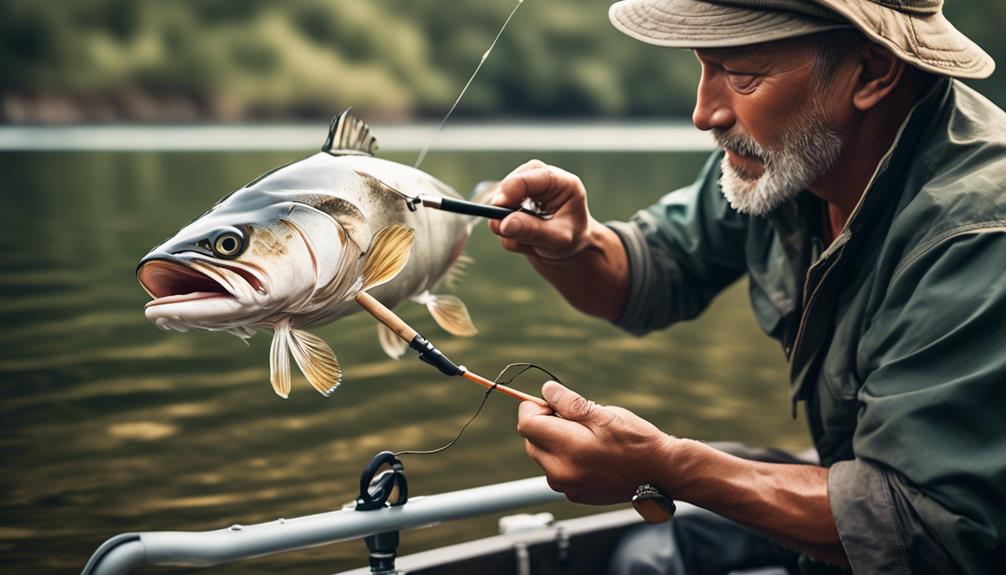
When practicing catch and release, it's essential to handle fish carefully to minimize stress and maximize their chances of survival, thereby contributing to the overall conservation of aquatic ecosystems.
To ensure the best practices for catch and release, consider the following techniques:
- Use BarbleSS Hooks: Opt for barbless hooks to reduce injury and make hook removal easier, minimizing the handling time and stress on the fish.
- Minimize Air Exposure: Keep the fish in the water as much as possible. Prolonged air exposure can lead to stress, decreased oxygen levels, and potential harm to the fish.
- Handle with Wet Hands: When handling the fish, use wet hands or a wet cloth to avoid damaging the protective mucous layer on their skin. This layer helps prevent infections and diseases.
- Proper Release: Gently hold the fish in the water, allowing it to regain strength. Ensure the fish is upright and swimming strongly before letting go to improve its chances of survival.
Sustainable Fishing Practices
To ensure sustainable fishing practices, it's crucial to prioritize the conservation of fish populations and their habitats while promoting responsible harvesting techniques. Sustainable fishing involves practices that allow fish populations to replenish, ensuring the long-term viability of fish stocks and the health of aquatic ecosystems. Conservation efforts play a key role in achieving this goal.
Conservation efforts in sustainable fishing encompass various strategies aimed at maintaining healthy fish populations and preserving their habitats. This includes implementing catch limits and size regulations to prevent overfishing, protecting important breeding and spawning grounds, and minimizing the impact of fishing gear on the marine environment. By adhering to these measures, you can contribute to the preservation of fish populations and the overall health of aquatic ecosystems.
Additionally, sustainable fishing practices involve adopting responsible harvesting techniques. This means using gear and methods that minimize bycatch, avoid damage to marine habitats, and reduce the overall ecological footprint of fishing activities. Furthermore, practicing proper fish handling and release techniques when engaging in catch and release fishing can help minimize stress on fish populations, improving their chances of survival after being caught and released.
Frequently Asked Questions
What Are the Potential Legal Implications of Catch and Release Fishing?
When it comes to catch and release fishing, it's important to be aware of the potential legal implications and ethical considerations.
Depending on the location and specific regulations, there may be laws governing the practice of catch and release, including rules about handling and releasing fish.
It's crucial to familiarize yourself with the local fishing regulations to ensure you're in compliance with the law and contributing to sustainable fishing practices.
Are There Specific Types of Fish That Should Never Be Kept?
When considering types of fish, it's important to be mindful of conservation efforts. Some fish species, like endangered or threatened ones, should never be kept.
It's crucial to check local regulations and guidelines to ensure that you aren't unintentionally harming the ecosystem.
How Can Anglers Ensure They Are Using the Most Humane Techniques for Catch and Release?
To ensure you're using the most humane techniques for catch and release, prioritize fish welfare and ethical practices.
As an angler, it's your responsibility to practice sustainable fishing. Use barbless hooks, handle fish with wet hands, and minimize air exposure. Avoid overplaying fish, and release them gently. Consider using circle hooks, which reduce injury.
What Are the Potential Environmental Impacts of Keeping Fish?
Keeping fish can have potential environmental impacts. These impacts include disrupting the balance of aquatic ecosystems and reducing fish populations. Conservation efforts are important in minimizing these impacts. They involve adhering to catch limits, using sustainable fishing methods, and releasing undersized or endangered species. By being mindful of the environmental impact of keeping fish and supporting conservation efforts, anglers can help preserve the health and diversity of aquatic environments for future generations.
How Can Anglers Contribute to Conservation Efforts While Fishing?
To contribute to conservation efforts while fishing, you can practice ethical fishing practices. This includes following catch and release guidelines, using barbless hooks, and minimizing handling time. By doing so, you help protect fish populations and their habitats.
Additionally, supporting conservation organizations and participating in clean-up events at fishing spots are impactful ways to give back to the environment.
Your actions as an angler can make a real difference for conservation.
Conclusion
Remember, whether you choose to catch and release or keep fish, it's important to consider the impact of your actions on the fish population and the environment.
By following best practices for catch and release and using sustainable fishing practices, you can enjoy the sport of fishing while also contributing to the health and preservation of our aquatic ecosystems.
Happy fishing!
